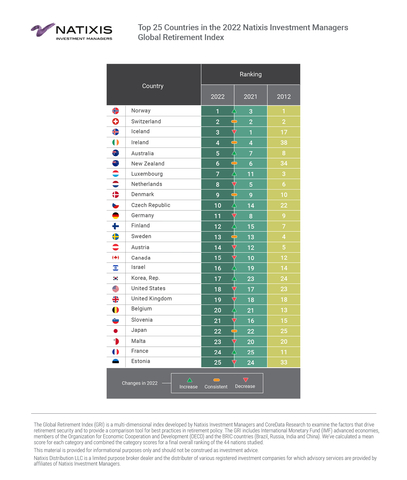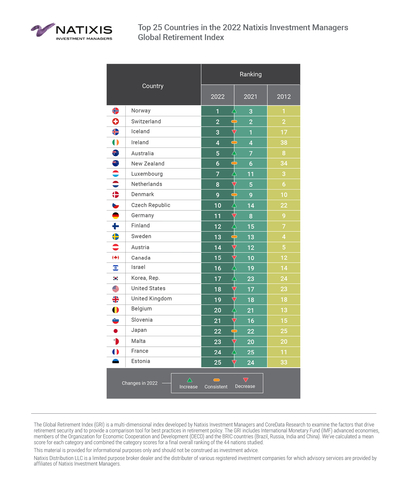BOSTON--(BUSINESS WIRE)--Canada dropped five spots to 15th place out 44 developed countries in the Natixis Investment Managers 2022 Global Retirement Index (GRI), a precipitous fall after attaining Top Ten status in the ranking for the first time last year. The annual index, which marks its 10th anniversary this year, shows erosion in key factors affecting the financial security and material wellbeing of Canadian retirees. In a year on track to be one of the worst on record to retire, the market downturn coupled with runaway inflation and successive interest rate hikes poses an immediate threat to retirees and suggests the need for new thinking about retirement planning and policy.
“Getting retirement security right so that people can live with dignity after their working years is a core sustainability issue for society and one of the most important mandates for governments and the financial industry,” said Liana Magner, Executive Vice President and Head of Retirement and Institutional in the US for Natixis Investment Managers, speaking today to a gathering of large US retirement plan sponsors at the annual Institutional Investor-Defined Contribution Institute in Half Moon Bay, California. “The GRI provides insight into the levers that can drive or diminish the wellbeing of retirees, and it serves as an important benchmarking tool for policymakers, employers, financial professionals and individuals.”
Natixis Investment Managers (Natixis IM) created the Global Retirement Index in collaboration with Core Data Research to establish a global benchmark that incorporates the wide variety of factors essential for people to enjoy a healthy and secure retirement including not only important financial factors but also access to and cost of healthcare, climate conditions, the state of governance and general happiness of the population. The GRI rankings are based on an aggregate of mean scores from 0% to 100% for 18 performance measures in each of four sub-indices – Finances in retirement, material wellbeing, health, and quality of life – which are combined to provide an overall picture of the environment for retirees.
For the four sub-indices, Canada ranks as follows in the 2022 GRI:
- 11th for Health
- 12th for Finances
- 16th for Quality of Life
- 27th for Material Wellbeing
Canada’s overall 2022 ranking is similar to what it was a decade ago when it placed 12th in 2012. Compared to last year’s index, Canada received lower scores in all three key indicators of material wellbeing: income equality, income per capita and employment. Lower scores in the Finance sub-index were driven by increased tax pressure, rising interest rates, a higher ratio for old-age dependency (the number of people age 65+ per 100 people of working ages 15-64), and government indebtedness. The bright spot for Canada is that it has the second highest score in the Finance sub-index for bank nonperforming loans, an indicator of the strength of Canada’s banking system.
For Quality of Life, Canada maintained its 16th place ranking, despite a small slide in the happiness indicator and on some environmental factors. While Canada has the seventh highest score for air quality, it has the eighth-lowest score in the index for biodiversity, an indicator of the country’s protection of its ecosystem.
Canada also maintained the same ranking in the Health sub-index as last year as an increase in per capita health spending was neutralized by an increase in the proportion of health spending that is uninsured, as well as a slight decline in scores for Canadian life expectancy.
Global rankings
- After four years in the No. 3 spot, Norway reclaimed its No. 1 ranking in the 2022 GRI.
- Iceland, which has held the top spot since 2018, fell to 3rd, while Switzerland held its strong position at No. 2.
- The remainder of the Top Ten countries this year are Ireland (4th), Australia (5th), New Zealand (6th), Luxembourg (7th), Netherlands (8th), Denmark (9th), and the Czech Republic (10th).
- Luxembourg and the Czech Republic entered the list of top ten countries for the first time this year, rising to No. 7 and No. 10, respectively. Germany and Canada, which were among the top ten countries last year, fell to No. 11 and No. 15, respectively, in this year’s GRI.
- Ireland stands out as having the biggest gain in GRI ranking over the past ten years, rising to 4th from 38th in 2012. New Zealand, Iceland, and the Czech Republic also are among the biggest gainers.
Biggest Risks to Retirement Security: Inflation, Rates, Longevity
The responsibility for retirement security continues to fall heavily on individuals and their personal savings. Longevity is the all-important part of the equation that drives all other inputs including how much money is needed, investment return expectations and spending rates. According to Natixis IM’s 2022 survey of financial advisors in Canada, the biggest retirement planning mistakes Canadian investors make are:
- Underestimating how long they will live: 65%
- Underestimating the impact of inflation: 61%
- Forgetting to factor in healthcare costs: 60%
- Not understanding sources of income in retirement: 51%
- Being too conservative in investments: 48%
“Retirement security challenges have come home to roost in 2022,” said Dave Goodsell, Executive Director of the Natixis IM Center for Investor Insight. “Inflation has been the long-sleeping giant of worries for retirees and is now at the apex of retirement security threats. The rate hikes the Bank of Canada and other central banks have implemented to quell inflation further compound the problem, creating short-term pain for retiree portfolios. Investment strategies, financial planning, employee benefits and policy considerations will all need to factor in a new funding equation that accounts for inflation, interest rates, and increased longevity.”
The challenges to retirement security are particularly problematic in countries with a pay-as-you-go retirement system, which is the model for Social Security in the US and many elements of the Canada Pension Plan. The growing population of seniors relative to the workforce breaks the underlying earnings-based insurance formula on which the retirement system is based and presents limited options for policymakers that will be especially difficult as retirement benefits compete with a rising public debt.
Natixis IM’s report on the 2022 GRI and ten-year retrospective on movement in the index as individual countries have sought various strategies for addressing the retirement security challenges provides valuable insight for policymakers and all stakeholders.
To view and download a full copy of the report, visit https://www.im.natixis.com/intl/research/2022-global-retirement-index.
Methodology
The Global Retirement Index assesses factors that drive retirement security across 44 countries where retirement is a pressing social and economic issue. It was compiled by Natixis Investment Managers with support from CoreData Research. The index includes International Monetary Fund (IMF) advanced economies; members of the Organization for Economic Cooperation and Development (OECD); and the BRIC countries (Brazil, Russia, India and China). The researchers calculated a mean score in each category and combined the category scores for a final overall ranking of the 44 nations studied.
About the Natixis Center for Investor Insight
The Natixis Center for Investor Insight is a global research initiative focused on the critical issues shaping today’s investment landscape. The Center examines sentiment and behavior, market outlooks and trends, and risk perceptions of institutional investors, financial professionals and individuals around the world. Our goal is to fuel a more substantive discussion of issues with a 360° view of markets and insightful analysis of investment trends.
About Natixis Investment Managers
Natixis Investment Managers’ multi-affiliate approach connects clients to the independent thinking and focused expertise of more than 20 active managers. Ranked among the world’s largest asset managers1 with more than $1.1 trillion assets under management2 (€1.1 trillion), Natixis Investment Managers delivers a diverse range of solutions across asset classes, styles, and vehicles, including innovative environmental, social, and governance (ESG) strategies and products dedicated to advancing sustainable finance. The firm partners with clients in order to understand their unique needs and provide insights and investment solutions tailored to their long-term goals.
Headquartered in Paris and Boston, Natixis Investment Managers is part of the Global Financial Services division of Groupe BPCE, the second-largest banking group in France through the Banque Populaire and Caisse d’Epargne retail networks. Natixis Investment Managers’ affiliated investment management firms include AEW; AlphaSimplex Group; DNCA Investments;3 Dorval Asset Management; Flexstone Partners; Gateway Investment Advisers; Harris Associates; Investors Mutual Limited; Loomis, Sayles & Company; Mirova; MV Credit; Naxicap Partners; Ossiam; Ostrum Asset Management; Seeyond; Seventure Partners; Thematics Asset Management; Vauban Infrastructure Partners; Vaughan Nelson Investment Management; and WCM Investment Management. Additionally, investment solutions are offered through Natixis Investment Managers Solutions and Natixis Advisors, LLC. Not all offerings are available in all jurisdictions. For additional information, please visit Natixis Investment Managers’ website at im.natixis.com | LinkedIn: linkedin.com/company/natixis-investment-managers.
Natixis Investment Managers’ distribution and service groups include Natixis Distribution, LLC, a limited purpose broker-dealer and the distributor of various U.S. registered investment companies for which advisory services are provided by affiliated firms of Natixis Investment Managers, Natixis Investment Managers S.A. (Luxembourg), Natixis Investment Managers International (France), and their affiliated distribution and service entities in Europe and Asia.
1 Cerulli Quantitative Update: Global Markets 2022 ranked Natixis Investment Managers as the 18th largest asset manager in the world based on assets under management as of December 31, 2021.
2 Assets under management (“AUM”) of current affiliated entities measured as of June 30, 2022 are $1,156.7 billion (€1,106.7 billion). AUM, as reported, may include notional assets, assets serviced, gross assets, assets of minority-owned affiliated entities and other types of non-regulatory AUM managed or serviced by firms affiliated with Natixis Investment Managers.
3 A brand of DNCA Finance.
The views and opinions expressed may change based on market and other conditions. This material is provided for informational purposes only and should not be construed as investment advice. There can be no assurance that developments will transpire as forecasted.
***
4937961.1.1





